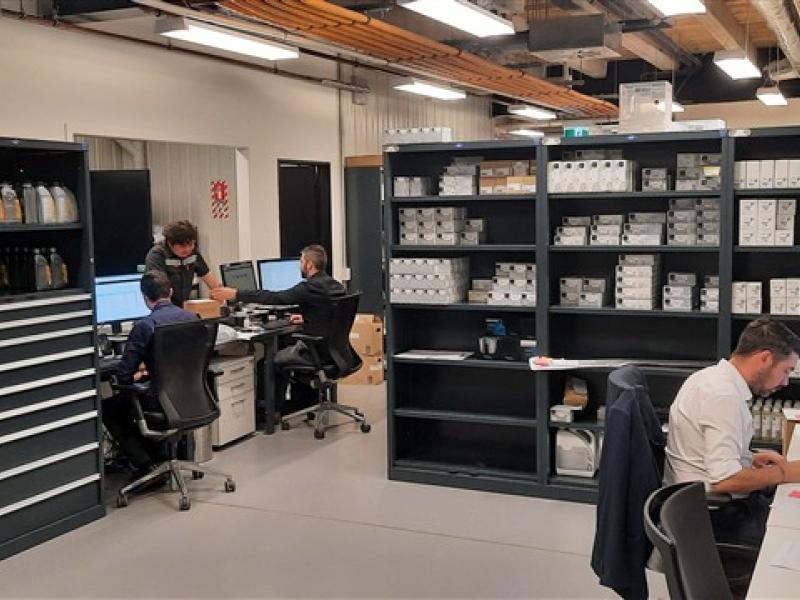The Mercedes-Benz 770 ‘Grand Mercedes’ took the lead in automotive engineering in 1930.
With the Mercedes-Benz 770 “Grand Mercedes”, launched 90 years ago in 1930, the brand forged ahead again in the automotive engineering field. These inherently representative cars featured exceptional driving performance and outstanding ride comfort. An eight-cylinder in-line engine with a displacement of 7.7 litres ensured that the W 07 model series’ drivetrain met the same exacting standard. The “Grand Mercedes”, built between 1930 and 1938, remained a highly exclusive vehicle, and only 117 units were built, in a number of different versions. It was succeeded by the W 150 model series, which bore exactly the same model designation – 770 “Grand Mercedes”. The W 07 was a milestone in the tradition of cars that are rated amongst the best in the world – right up to today’s Mercedes Maybach S-Class luxury and representative vehicles.
Magnificent exhibits: There are no less than two of the 770 “Grand Mercedes” to be admired at the Mercedes-Benz Museum in Untertürkheim. One of these is the Cabriolet F, which was custom-built in 1932 for the German Emperor, Kaiser Wilhelm II, who was living in exile in the Netherlands at that time. The radiator was decorated with the Hohenzollern coat of arms instead of the Mercedes star. The navy blue exterior finish was the Emperor’s tribute to the German naval fleet. Right next to it is the Pullman limousine belonging to the Japanese Emperor Hirohito, which, in 1935, was one of the first cars ever to be delivered as an armoured special protection version. Especially thick, multilayer glazing on the side and rear windows as well as an armour-plated roof and doors were some of the protective measures. One interesting detail was that both these cars were amongst the few W 07s that were supplied without a supercharger.
Premiere in Paris: The Mercedes-Benz 770 “Grand Mercedes” was launched in October 1930 at the Salon de l’Automobil in Paris, the world’s leading motor show at the time. This, the largest, heaviest and also most expensive model in the Mercedes-Benz passenger car range secured the then Daimler-Benz AG a leading position in international car construction. A contemporary Mercedes-Benz brochure left no doubt as to the validity of this claim and referred to the “most powerful passenger car in Germany and one of the largest in the world”. It continued: “This is the car with that special touch, created for the most demanding requirements, for the circle of leading men of all countries who always demand the highest standard of performance and comfort.”
The development: After two years of development work, the Board of Management decided at their meeting on 6 March 1930 to accelerate development of the W 07 to production standard and to complete the Nürburgring trials by the end of May of that year. On 6 June 1930, the new Chairman of the Board, Wilhelm Kissel, summed it up: the “development of a new large car” was necessary so that there was an up-to-date luxury-class vehicle in the model range once again. With reference to the company’s self-imposed demands on the design of the W 07, Kissel said: “It goes without saying that this car has to meet the standards expected of Daimler-Benz.”
Technology: In contrast to many a competitor, the team supervised by the head of the design office, Dr Hans Nibel, and head of engine development, Albert Heeß, did not opt for a twelve-cylinder engine but for an eight-cylinder in-line engine with a displacement of 7.7 litres. Its maximum speed was 2,800 rpm. This M 07 produced 110 kW (150 hp), and, if the Roots supercharger was engaged while the accelerator was fully depressed, the power output was 147 kW (200 hp). For a price reduced by RM 3,100, the “Grand Mercedes” was also available without a supercharger. However, only 13 of the 117 customers chose this option. One of the two spark plugs per cylinder was connected to a high-voltage magneto ignition system and the other to a battery.
Sophisticated design: Power was transmitted through a three-speed transmission, which was supplemented by a virtually silent Maybach overdrive system which could be switched in for any of the three forward gears. So, in practice, there were six gears available. The overdrive system was switched in without operating the clutch but simply by activating a semi-automatic vacuum shift mechanism by means of a lever on the steering column. The four wheel brakes were operated mechanically and were supported by a Bosch-Dewandre servo-brake. The “Grand Mercedes” had a rigid axle made of an H-section at the front and a rigid banjo axle at the rear. It had a fully automatic central lubrication system. The fine balance of the chassis, which was of a rather conservative design but very well received by the experts, resulted in optimum safety and comfort. The top-of-the-range model from Mercedes-Benz was supplied fitted with either wooden spoke wheels or wire spoke wheels, with Rudge knock-off hubcaps for quick wheel changing.
Technical data (1930): Eight-cylinder in-line engine, 7,655 cc, output: 110 kW (150 hp) or, with supercharger, 147 kW (200 hp) at 2,800 rpm. Fuel consumption was around 28 to 30 litres per 100 kilometres, fuel tank capacity 120 litres. Maximum speed with the supercharger switched in was around 160 km/h. Weight of the chassis: 1,950 kg, weight of complete vehicle: 2,700 kg, wheelbase: 3,750 mm, overall length: 5,600 mm.
Variants: The bodies of the “Grand Mercedes” were produced at the special vehicle production unit in Sindelfingen. Final assembly and handover to the customer took place in Stuttgart-Untertürkheim. Initially, the Pullman limousine, of which 42 were manufactured, was offered with six or seven seats. In September 1932, cabriolet models B, C, D and F and an open touring car were added to complete the choice of bodies available. On top of that, there were also bodies provided by private coachbuilders, such as Erdmann & Rossi. Body design was modified through the 1930s to result in more fluid forms.
Pricing: A comparison shows how clearly the W 07 stood out from the generally applicable price level: the Pullman limousine with the supercharger was offered for RM 41,000 during the entire production period from 1930 to 1938, while the 170 (W 15), launched in 1931, was offered for RM 4,400. Even the 540 K, which also contributed a great deal to the reputation of Mercedes-Benz during the 1930s, cost RM 22,000 in 1936, fractionally more than half the price of the “Grand Mercedes”.
In the eyes of the press: Trade magazine Motor und Sport had this to say in its 24/1932 issue: “In contrast to familiar models by competitors, the behaviour of the Grand Mercedes at all speeds is impeccable. […] We are aware of no other vehicle that allows such danger-free driving with heavy vehicle bodies at the breath-taking speed of 120 km/h […that] and that can easily hold the speed of an express train.”






